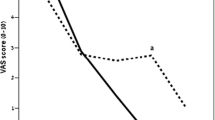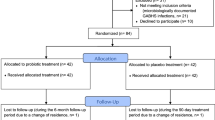Abstract
Recurrent episodes of infections in the upper respiratory tract are very common. The pathogenesis behind these recurrences is still not well understood, but much attention has been paid to the adherence of the microorganisms to epithelial structures and to the protective function of the normal bacterial flora (bacterial interference). Thus, in vitro as well as in vivo studies have shown that both aerobic and anaerobic bacteria of the normal flora in the upper respiratory tract can hinder the growth of pathogens and the establishment of a renewed infection. Studies have shown that lack of interfering bacteria facilitates recurrence of these diseases. Recolonization with interfering alpha-streptococci has been performed successfully in acute streptococcal pharyngotonsillitis, as well as in acute otitis media. The number of recurrences has significantly been lowered in these diseases after recolonization with alpha-streptococci, which is the dominating normal bacteria in the upper respiratory tract. Several mechanisms have been proposed to be responsible for this interaction, such as competition of the adhering sites at the epithelial cells, production of hydrogen peroxide, competition for nutritients, and production of specific growth inhibiting factors such as bacteriocins. Other human components like lactoferrin are also important in the defense against microorganisms, and are important parts of the unspecific and specific immune system.
Similar content being viewed by others
References and Recommended Reading
Houvinen P: Bacteriotherapy: the time has come. BMJ 2001, 323:353–354.
Bibel DJ, Aly R, Bayles C, et al.: Competetive adherence as a mechanism of bacterial interference. Can J Microbiol 1983, 29:700–703.
Maassen CBM, vanHolten-Neelen B, Balk F, et al.: Strain dependent induction of cytokine profiles in the gut by orally administered Lactobacillus strains. Vaccine 2000, 18:2613–2623.
Skotnik B, Hassman E: Cytokines in children with otitis media with effusion. Eur Arch Otorhinolaryngol 2000, 4:323–326.
Faden H: Comparision of the local immune response to nontypable Haemophilus influenzae (nHI) and Moraxella Catarrhalis (MC) during otitis media. Adv Exp Med Biol 1995, 21:733–736.
Lilja M, Mykleburst R, Räisänen S, Stenfors L-E: Selective attachement of b-Haemolytic Streptococci group A to oropharyngeal epithelium in health and disease. Acta Otolaryngol (Stockh) 1997, 117:744–749. Study shows the difference between carriers and infected patients.
Hendolin PH, Markakanen A, Ylikoski J, Wahlfors JJ: Use of multiplex PCR for simultaneous detection of four bacterial species in middle ear effusions. J Clin Microbiol 1997, 35:2845–2848.
Gok U, Bulut Y, Keles E, et al.: Bacteriological and PCR analysis of clinical material aspirated otitis media with effusions. Int J Pediatr Otorginolaryngol 2001, 60:49–54.
Jack RW, Tagg JR, Ray B: Bacteriocins of gram-positive bacteria. Microbiol Rev 1995, 59:171–200.
Dajani A, Tom M, Law DJ: Viridins, bacteriocins of alphahemolytic Streptococci: Isolation, characterization and partial purification. Antimicrob Agents Chemother 1976, 9:81–88.
Rotimi VO, Duerden BI: The development of the bacterial flora in normal neonates. J Med Microbiol 1981, 14:51–62.
Bjerkli IH, Mykleburst R, Räisänen S, et al.: Bacterial attachment to oropharyngeal epithelial cells in breastfed newborns. Int J Pediatr Otorhinolaryngol 1996, 36:205–213.
Sanders E: Bacterial interference. Its occurrence among the respiratory tract flora and characterization of inhibition of group A streptococci by viridans streptococci. J Infect Dis 1969, 120:698–707.
Grahn E, Holm S, Ekedahl C, Roos K: Interference of alphahemolytic streptococci isolated from tonsillar surface on beta-hemolytic streptococci (S pyogenes) - a methodological study. Zbl Bact Hyg A 1983, 254:459–468.
Brook I, Gober A: Interference by aerobic and anaerobic bacteria in children with recurrent group A beta-hemolytic streptococcal tonsillitis. Arch Otolaryngol Head Neck Surg 1999, 125:552–554. The study states that several species in the normal flora are involved in bacterial interference.
Ågren K, Lundberg C, Nord CE: Effects of Amocycillin/clavulanic acid on the aerobic and anaerobic tonsillar microflora in the treatment of recurrent tonsillitis. Scand J Infect Dis 1990, 22:691–697.
Brook I, Gober AE: Bacterial interference in the nasopharynx following antimicrobial therapy of acute otitis media. J Antimicrob Chemother 1998, 41:489–492.
Roos K, Grahn E, Holm SE: Evaluation of beta-lactamase activity and microbial interference in treatment failures of acute streptococcal tonsillitis. Scand J Infect Dis 1986, 18:313–319.
Fujimori I, Kikushima K, Hisamatsu K, et al.: Interaction between oral alpha-streptococci and group A streptococci in patients with tonsillitis. Ann Otol Rhinol Laryngol 1997, 106:571–574.
Grahn E, Holm SE: Bacterial interference in the throat flora during a streptococcal tonsillitius outbreak in an appartment house area. Zbl Bact Hyg A 1983, 256:72–79.
Bernstein J, Faden H, Dryja D, Wactawski-Wende J: Micro-ecology of the nasopharyngeal bacterial flora in otitis-prone children. Acta Otolaryngol (Stockh) 1993, 113:88–92.
Brook I, Yocum P: Bacterial interference in the adenoids of otitis media-prone children. Pediatr Infect Dis J 1999, 18:835–837.
Fujimori I, Hisamatsu K, Kikushima K, et al.: The nasopharyngeal flora in children with otitis media with effusion. Eur Arch Otorhinolaryngol 1996, 253:260–263.
Tano K, Grahn-Håkansson E, Holm SE, Hellström S: Inhibition of pathogenes by alpha-streptococci from healthy children, children with SOM and children with rAOM. Int J Pediatr Otorhinolaryngol 2000, 56:185–190. Study shows the qualitative differences between alpha-streptococci in children.
Brook I, Gober AE: In vitro bacterial interference in the nasopharynx of otiti media-prone and non-otitis-mediaprone children. Arch Otolaryngol Head Neck Surg 2000, 126:1011–1013.
Tano K, Olofsson C, Grahn-Håkansson E, Holm SE: In vitro inhibition of S. pneumoniae, nontypable H. influenzae and M. catharralis by alpha-hemolytic streptococci from healthy children. Int J Pediatr Otorhinolaryngol 1999, 47:49–56.
Sprunt K, Leidy G: The use of bacterial interference to prevent infection. Can J Microbiol 1988, 34:332–338.
Roos K, Grahn E, Holm SE, et al.: Interfering alpha-streptococci as a protection against recurrent streptococcal tonsillitis in children. Int J Pediatr Otorhinolaryngol 1993, 25:142–148.
Roos K, Holm SE, Grahn E, Lind L: Alpha-streptococci as supplementory treatment of recurrent streptococcal tonsillitis: a randomised placebo-controlled study. Scand J Infect Dis 1993, 25:31–35.
Roos K, Holm SE, Grahn E, Lagergren L: Recolonization with four selected alpha-streptococcal strains in the treatment of recurrent streptococcal tonsillitis - a placebo-controlled randomized multicenter study. Scand J Infect Dis 1996, 34:542–584.
Falck G, Grahn-Håkansson E, Holm SE, et al.: Tolerance and efficacy of interfering alpha-streptococci in recurrence of streptococcal pharyngotonsillitis: a placebo-controlled study. Acta Otolaryngol (Stockh) 1999, 119:944–948. Large recolonization study that shows the efficacy of selected alphastreptococcal strains in patients with nonrecurrent streptococcal pharyngotonsillitis.
Roos K, Grahn Håkansson E, Holm S: Effect of recolonisation with "interfering" alpha-streptococci on recurrences of acute and secretory otitis media in children: randomised placebo controlled trial. BMJ 2001, 322:210–212. Significant efficacy of recolonization with selected alpha-streptococci against otopathogens in otitis-prone children.
Brook I, Gober A: Bacterial interference in the nasopharynx and nasal cavity of sinusitis prone and not sinusitis prone children. Acta Otolaryngol (Stockh) 1999, 119:832–836. The study shows that the interfering phenomenon probably also exists in sinusitis.
Metchnikoff E: Recherches sur le cholera et les vibrions. IV. Sur límmunité et la receptivé vis-a-vis du cholera intestinal. Ann Inst Pasteur (Paris) 1894, 8:529–589.
Underdown BJ, Schiff JM: Strategic defence initiative at the mucosal surfaces. Ann Rev Immunol 1996, 8:389–417.
Shousboe LP, Ovesen T, Eckhardt L, et al.: How does endotoxin trigger inflammation in otitis media with effusion. Laryngoscope 2001, 111:297–300.
Leibovitz E, Dagan R, Laver JH, et al.: Interleukin 8 in middle ear fluid during acute otiis media: correlation with etiology and bacterial eradication. Arch Dis Child 2000, 82:165–168.
Stjernquist-Desatnik A, Warfing H, Johansson M-L: Persistence of Lactobacillus plantarum DSM 9843 on human tonsillar surface after oral administration in fermented oatmeal gruel. Acta Otolaryngol 2000, 543(Suppl):215–219.
Hatakka K, Savilahti E, Pönkä A, et al.: Effect of long-term consumption of probiotic milk on infections in children attending day care centres: double blind, randomised trial. BMJ 2001, 322:1327–1329. Very interesting study on the efficacy of lactobacteria in avoiding upper respiratory tract infections.
Brock J: Lactofferin: a multifunctional immunoregulatory protein/ Immunol Today 1995, 16:417–419.
Author information
Authors and Affiliations
Rights and permissions
About this article
Cite this article
Roos, K., Holm, S. The use of probiotics in head and neck infections. Curr Infect Dis Rep 4, 211–216 (2002). https://doi.org/10.1007/s11908-002-0081-4
Issue Date:
DOI: https://doi.org/10.1007/s11908-002-0081-4




